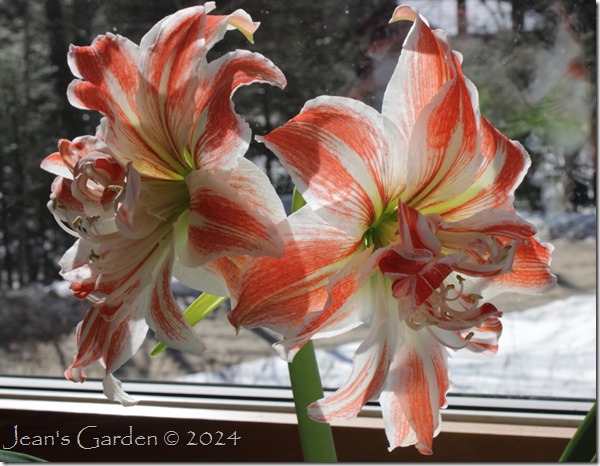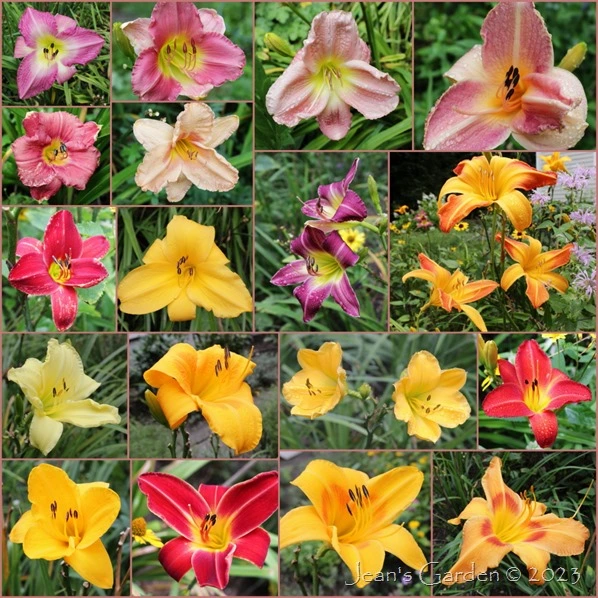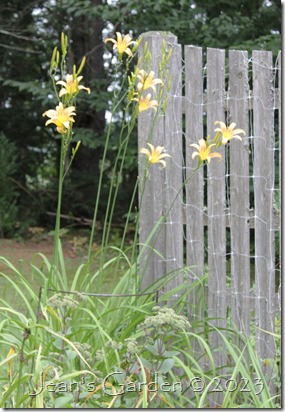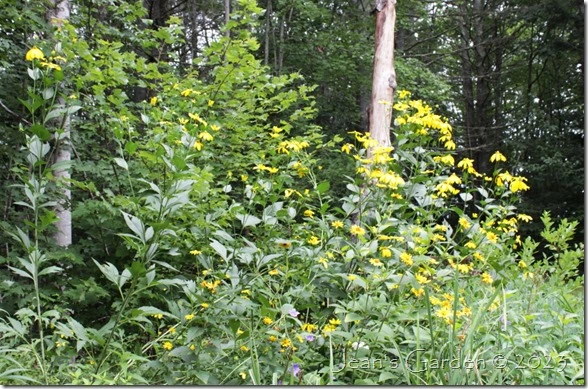Warm Blooms for Winter Days: GBBD, February 2024
 In Maine, we are on the downhill side of winter, more than halfway from the winter solstice to the spring equinox. Days are getting longer, and the higher angle of the sun, combined with temperatures above freezing on many days, is melting snow. I can see bare ground under trees and along the foundation of the house, where some new shoots of green are visible.
In Maine, we are on the downhill side of winter, more than halfway from the winter solstice to the spring equinox. Days are getting longer, and the higher angle of the sun, combined with temperatures above freezing on many days, is melting snow. I can see bare ground under trees and along the foundation of the house, where some new shoots of green are visible.
Despite these hints of spring to come, it will be about six weeks until the first flowers bloom out in the garden. This is a time of year, when winter is getting old and I am eager for spring, that I particularly welcome the warm colors of indoor blooms. Potted amaryllis (Hippeastrum) bulbs fill the bill.
In late October, I put the potted bulbs away in the basement for a period of dormancy. I began taking them out again in late December, one-third at a time, to stagger their blooming. Hippeastrum is a tropical bulb that likes heat, so it takes them a while to grow in my cool winter house. The first to flower was ‘Dancing Queen,’ a plant with big red-orange and white double flowers that I received as a Christmas gift from a friend several years ago. I’m not normally a fan of double flowers, but this one provides a big, delightful splash of cheerful warmth in the depth of winter, and it always makes me smile. Because the flower stem is very tall (possibly another effect of slow growth in a cool environment), I’ve placed ‘Dancing Queen’ on the floor in front of a glass door that leads out to the deck from my bedroom. The door doesn’t get used in winter, and this position means that I see the flowers first thing each morning, backlit by the rising sun.
By the time these flowers fade, other varieties will follow. Currently, I have developing buds on four additional amaryllis bulbs. When they finish blooming, the first flowers of spring will be opening outdoors.
Garden Bloggers’ Bloom Day is a tradition developed and hosted each month by Carol Michel at May Dreams Gardens. Visit her blog to see what other gardeners have blooming in February.
The Pleasures of a Messy Garden
 The only fall clean-up I do in my garden involves bringing in garden furniture, hoses, and plant supports for the winter. I prefer to leave plant seed heads as food and spent plant stems and leaves as habitat. Admittedly, all this plant debris can look pretty messy, especially to the eyes of those who prefer a neat garden. But messiness brings its own pleasures.
The only fall clean-up I do in my garden involves bringing in garden furniture, hoses, and plant supports for the winter. I prefer to leave plant seed heads as food and spent plant stems and leaves as habitat. Admittedly, all this plant debris can look pretty messy, especially to the eyes of those who prefer a neat garden. But messiness brings its own pleasures.
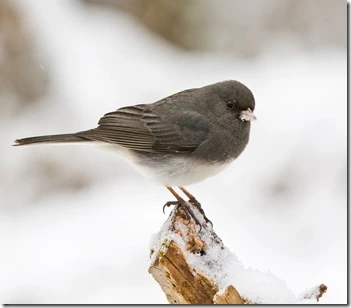 After weeks of weirdly warm and wet weather, it finally turned seasonably cold and snowy in the second half of January. One morning, I looked out my big bedroom window to see a few dark-eyed juncos (Junco hyemalis) feeding in the front garden. Juncos are small sparrow-like birds. They live year-round in Maine, but I am most likely to see them in fall and winter, and I think of them as winter birds. On this day, their feathers were fluffed out for insulation against the cold, and they looked like so many little balls.
After weeks of weirdly warm and wet weather, it finally turned seasonably cold and snowy in the second half of January. One morning, I looked out my big bedroom window to see a few dark-eyed juncos (Junco hyemalis) feeding in the front garden. Juncos are small sparrow-like birds. They live year-round in Maine, but I am most likely to see them in fall and winter, and I think of them as winter birds. On this day, their feathers were fluffed out for insulation against the cold, and they looked like so many little balls.
 The next morning brought a larger group of juncos to the front garden, where they went to work gleaning as much food as possible from the seed heads of spotted beebalm (Monarda punctata). I stood and watched them for quite some time. Although they are known as ground feeders, these juncos were mostly perched on the plant stems, swaying in the breeze and busily pecking at the seeds. Every so often, one or two would hop down to the ground to feed on seeds and
The next morning brought a larger group of juncos to the front garden, where they went to work gleaning as much food as possible from the seed heads of spotted beebalm (Monarda punctata). I stood and watched them for quite some time. Although they are known as ground feeders, these juncos were mostly perched on the plant stems, swaying in the breeze and busily pecking at the seeds. Every so often, one or two would hop down to the ground to feed on seeds and 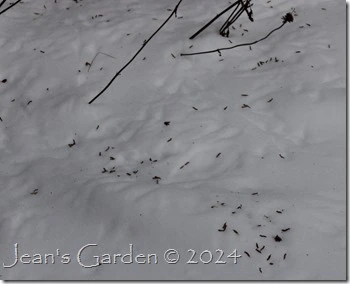 chaff dislodged from the seed heads and now littered on the surface of the snow.
chaff dislodged from the seed heads and now littered on the surface of the snow.
I would not have had the pleasure of watching these juncos feeding right outside my window if it were not for my messy winter garden.
Reimagining the Serenity Garden
When I created the serenity garden a dozen years ago in a tucked away space at the edge of the woods, I imagined it as a quiet, secluded, calming retreat. This was my first woodland planting, and I eagerly consulted my garden reference books, choosing just the right plants for this special place. I chronicled the vision, planning, and creation of this garden here, here, and here. This is the original plan for this planting.
From the beginning, this planting never lived up to either my vision or its name. It turned out that the combination of my native sandy soil and the competition for moisture from pine tree roots left too little moisture for many of the shade-loving plants I had chosen. Of the original plants, the only ones that thrived in this location were the columnar boxwood ‘Green Mountain,’ goatsbeard (Aruncus dioicus) and the fern Athyrium felix-femina ‘Lady in Red.’ Some plants, like Anemone hupihensis, Heuchera x ‘Raspberry Ice,’ Iris reticulata, Geranium x ‘Patricia’ and cinnamon fern (Osmunda cinnamomea), disappeared completely within a few years. Others, like Actaea, Lycoris squagmera, and Amsonia hubrichtii, put up new foliage each spring, but never grew any larger and never bloomed. Other plants started out well, but grew smaller and less likely to bloom over time. These included Astrantia major, Lamprocapnos spectabilis ‘Goldheart,’ the two hostas, the hellebores, the crocus bulbs, Geranium maculatum ‘Espresso,’ and Geranium x cantabrigiense ‘Biokovo.’ Two of the three shrubs in the original planting, the Viburnum cassenoides and Pieris x ‘Brouwer’s Beauty,’ also struggled in this location.
Over the years, I have tried new plants to replace the unhappy ones in this planting. Many of these proved to be just as unhappy as the plants they replaced, but a few were successes. One year, I dug out the miserable-looking Viburnum cassenoides and replaced it with Viburnum acerifolium, a plant that grows along the side of the road in my neighborhood and that has grown happily in another part of my garden. This turned out to be a good choice. Another year, I came home from a “Plant Propagation” class at the Coastal Maine Botanical Gardens with a piece of a small epimedium. I divided it into three micro-divisions and planted them in the serenity garden, where they have happily spread and bloomed. When a friend gave me a little piece of her Iris cristata, I planted it where the Iris reticulata were once meant to grow; within a few years, it has grown into a large clump that puts on a brief, but spectacular, floral display each spring.
When I took a series of garden design classes at the Coastal Maine Botanical Gardens last year, I decided to work on redesign of this problematic planting as my class project. The course instructor gave me some very good advice about enlarging this planting to change its shape and focal point. When I came home after class, I tried out this idea by outlining the new shape on the ground with clothesline, and I liked what I saw.
This year, I have been working on realizing the redesign. When I mentioned to a friend last year that this planting, with all its problems, has never made me feel very serene, she said, “Maybe it needs a new name.” So, it is being reimagined as the “woodland retreat,” which captures its location set off from the rest of the garden and wrapped around by woods on three sides. I did a sun study of the enlarged site in late spring (after the deciduous trees had leafed out) and then developed a planting plan:
In recent weeks, I have removed vegetation and prepared the soil for the redesigned planting, adding organic matter by forking in compost and dehydrated cow manure. The few original plants that thrived where they were planted will be left in place, as will the replacement viburnum. Plants that will not remain in the new planting have been removed.
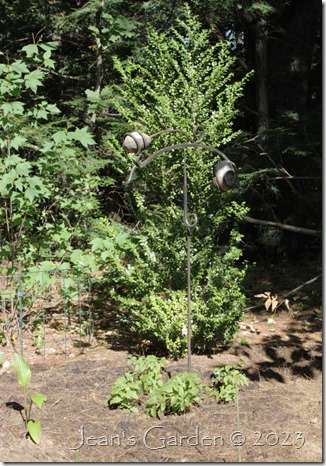 In this expanded planting, the boxwood that was originally at the edge of the planting becomes part of its focal point. I have moved the “rock spinner” sculpture that was dwarfed by the big pine trees to a new location in front of the boxwood, which shows it off to much better effect. The happy epimediums have been clustered around the base of the rock spinner, and the big clump of Iris cristata has been divided into three clumps. I had originally planned to take out the bowman’s root (Gillenia trifoliata) at the back of the planting because it has bloomed only sparsely most years. But, in this year’s very wet June, the plant bloomed profusely, which led me to not only keep it, but to add another one. (Climate change predictions are that this part of the country will become wetter.) I decided to keep the struggling Pieris x ‘Brouwer’s Beauty’ for the time being; I’ve pruned it back to healthy growth and added organic matter with a ring of compost around its roots. The struggling Hosta nigrescens has also been kept, in hopes that it will do better in a new location with newly amended soil.
In this expanded planting, the boxwood that was originally at the edge of the planting becomes part of its focal point. I have moved the “rock spinner” sculpture that was dwarfed by the big pine trees to a new location in front of the boxwood, which shows it off to much better effect. The happy epimediums have been clustered around the base of the rock spinner, and the big clump of Iris cristata has been divided into three clumps. I had originally planned to take out the bowman’s root (Gillenia trifoliata) at the back of the planting because it has bloomed only sparsely most years. But, in this year’s very wet June, the plant bloomed profusely, which led me to not only keep it, but to add another one. (Climate change predictions are that this part of the country will become wetter.) I decided to keep the struggling Pieris x ‘Brouwer’s Beauty’ for the time being; I’ve pruned it back to healthy growth and added organic matter with a ring of compost around its roots. The struggling Hosta nigrescens has also been kept, in hopes that it will do better in a new location with newly amended soil.
Everything else in this redesign is new, informed by a much better understanding of my soil conditions and of plants than I had twelve years ago and by observation of what has done well in woodland-adjacent plantings in my front garden. The addition of two more Viburnum acerifolium will help tie this planting to the woods behind by echoing the foliage of deciduous trees. In a similar way, the dwarf weeping hemlock (Tsuga canadensis ‘Cole’s Prostrate’) will reference the many hemlock trees that grow nearby. The two mountain laurel (Kalmia) plants are a risk, because I have never grown this genus before; but my research suggests that they should be well-suited to this site.
Earlier in the summer, I collected ripe seeds from native columbine (Aquilegia canadensis) plants in the front garden. I have direct-sown some of these at the front of the new planting; as an insurance policy, I will sow the remainder of the seeds in six-pack cells and overwinter them outside using instructions from the Wild Seed Project. After that, all that remains is to buy the new plants and get them into the ground. I will plant as many as I can this fall, adding the rest in spring. With luck, I will be enjoying my new woodland retreat next summer.
Approaching Autumn: GBBD, August 2023
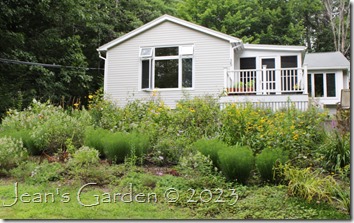 In this weirdly wet summer, it seems as though we hardly had any real summer weather, and, suddenly, I can feel the approach of autumn. In the woodland border, the foliage of our native columbine, Aquilegia canadensis, has turned to red and the Joe Pye weed (Eutrochium purpureum) is in bloom.
In this weirdly wet summer, it seems as though we hardly had any real summer weather, and, suddenly, I can feel the approach of autumn. In the woodland border, the foliage of our native columbine, Aquilegia canadensis, has turned to red and the Joe Pye weed (Eutrochium purpureum) is in bloom.
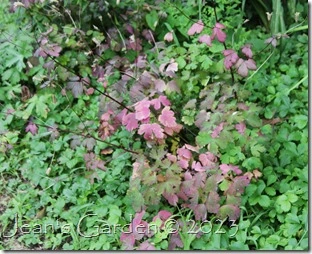 |
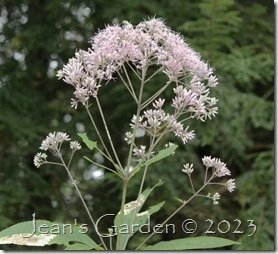 |
Nevertheless, summer is not over in the garden. In mid-August, there are still about twenty varieties of daylilies with flowers – but most of these have only a few buds left to open.
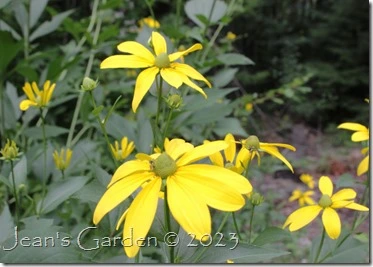 Another tall flower that blooms from late summer until frost is Rudbeckia x ‘Herbstsonne’ (aka ‘Autumn Sun’). This plant is putting on an amazing show at the back of the blue and yellow border, with flowers that are eight feet tall!
Another tall flower that blooms from late summer until frost is Rudbeckia x ‘Herbstsonne’ (aka ‘Autumn Sun’). This plant is putting on an amazing show at the back of the blue and yellow border, with flowers that are eight feet tall!
I am happy to be enjoying summer phlox (Phlox paniculata) this summer. Last year, the phlox were all eaten by the resident woodchuck, but this year’s woodchuck was removed from the garden by a predator in June, giving the phlox plants time to recover. Right now, both ‘Blue Paradise’ and ‘David’ are blooming in the back garden, with other cultivars in other parts of the garden in bud.
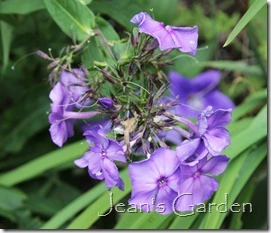 |
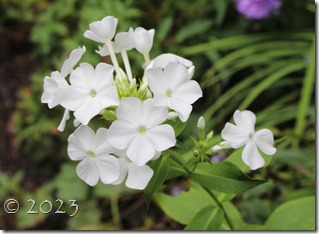 |
Other plants that have had an opportunity to bloom this year in the absence of the woodchuck are Liatris and Echinacea purpurea.
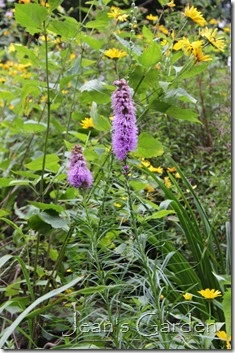 |
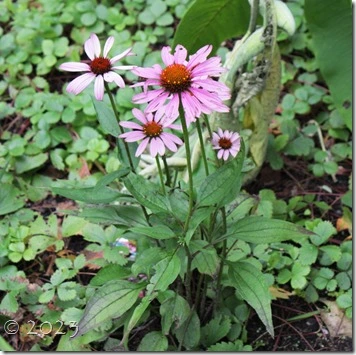 |
 In August, the front slope is dominated by beebalm, especially Monarda fistulosa and Monarda punctata. These plants are both enthusiastic self-seeders and can easily become too much of a good thing. I keep meaning to pull up excess quantities of Monarda punctata, but I hesitate to do so because this plant, with its pineapple-like tiers of pink bracts and spotted yellow flowers, is a magnet for pollinators. I particularly value the fact that it attracts the beautiful great black digger wasp, with its iridescent blue wings, to my garden.
In August, the front slope is dominated by beebalm, especially Monarda fistulosa and Monarda punctata. These plants are both enthusiastic self-seeders and can easily become too much of a good thing. I keep meaning to pull up excess quantities of Monarda punctata, but I hesitate to do so because this plant, with its pineapple-like tiers of pink bracts and spotted yellow flowers, is a magnet for pollinators. I particularly value the fact that it attracts the beautiful great black digger wasp, with its iridescent blue wings, to my garden.
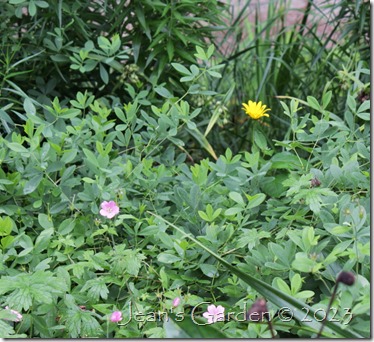 Another plant that is blooming profusely is false sunflower, Heliopsis helianthoides, which keeps popping up in places were I did not plant it, assisted I suspect by the goldfinches that like to perch on its stems and systematically strip the ray flowers from each blossom before eating the seeds.
Another plant that is blooming profusely is false sunflower, Heliopsis helianthoides, which keeps popping up in places were I did not plant it, assisted I suspect by the goldfinches that like to perch on its stems and systematically strip the ray flowers from each blossom before eating the seeds.
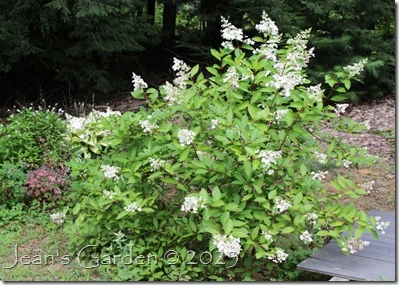 One plant that has been extra-happy with this year’s wet weather is my Hydrangea paniculata ‘Pinky Winky,’ which is planted in a depression that catches water from a downspout on the front corner of the house and has more blooms this year than I have ever seen on it before. Its flowers bloom white in late summer and then turn to pink and then to red. In mid-August, they are just beginning the transition to pink.
One plant that has been extra-happy with this year’s wet weather is my Hydrangea paniculata ‘Pinky Winky,’ which is planted in a depression that catches water from a downspout on the front corner of the house and has more blooms this year than I have ever seen on it before. Its flowers bloom white in late summer and then turn to pink and then to red. In mid-August, they are just beginning the transition to pink.
Even if the exuberant floral display of high summer is past, there is still plenty going on as my garden begins its turn from summer to autumn.
Garden Bloggers’ Bloom Day is a celebration of flowers hosted each month by Carol Michel at May Dreams Gardens. Visit her blog to see what other gardeners have blooming in August.
